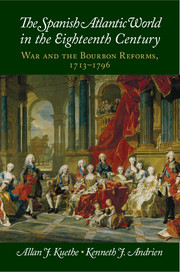Book contents
- Frontmatter
- Contents
- Introduction: War and Reform in Spain and Its Atlantic Empire
- I Alberoni, Patiño, and the Beginnings of Atlantic Reform, 1713–1736
- 1 Alberoni and the First Stirrings of Reform, 1713–1721
- 2 Alberoni and Colonial Innovation
- 3 José Patiño and the Revival of Reform, 1726–1736
- II The Second Wave of Reform, 1736–1763
- III Pinnacle of the Bourbon Reforms, 1763–1796
- Timeline for the Spanish Atlantic World in the Eighteenth Century
- Bibliography
- Index
- Plate section
- References
3 - José Patiño and the Revival of Reform, 1726–1736
Published online by Cambridge University Press: 05 June 2014
- Frontmatter
- Contents
- Introduction: War and Reform in Spain and Its Atlantic Empire
- I Alberoni, Patiño, and the Beginnings of Atlantic Reform, 1713–1736
- 1 Alberoni and the First Stirrings of Reform, 1713–1721
- 2 Alberoni and Colonial Innovation
- 3 José Patiño and the Revival of Reform, 1726–1736
- II The Second Wave of Reform, 1736–1763
- III Pinnacle of the Bourbon Reforms, 1763–1796
- Timeline for the Spanish Atlantic World in the Eighteenth Century
- Bibliography
- Index
- Plate section
- References
Summary
Following the collapse of Alberoni’s attempt to recapture control of Spanish ports and the colonial trade, his successors worked to revive transatlantic commerce through the legal system of fleets, but this effort faced enormous obstacles and would enjoy only limited success. Spain’s ministers had to hinder the South Sea Company’s commercial activities – legal and illegal – while also limiting the smuggling of Dutch, French, and British traders working independently of the South Sea Company. Foreign traders, particularly in Britain, had long sought direct trade with the Spanish empire, and they viewed the Spanish crown’s attempts to regulate commerce with the Indies as an unfair restriction of free trade. The Spanish regarded commerce in the Spanish Atlantic as a closed metropolitan monopoly, and they wanted to shut out all foreign intruders. This involved gaining control of sea lanes in the Caribbean, the Pacific, and the South Atlantic without provoking war with foreign rivals, particularly Great Britain, the premier naval power in the world. It also meant mediating among colonial and Spanish interest groups opposed to change, while dramatically curtailing the culture of political corruption in colonial bureaucracies in New Spain and Peru. It was a daunting task that fell to one of Spain’s most experienced ministers of the period, José Patiño. In his portrait (shown in Figure 3.1), Patiño appears every bit the proud, self-confident public servant, and his decade in power would be a time of real accomplishment.
Patiño’s ten years in power (1726–1736) saw none of the tumultuous political divisions in Spain and violent conflicts in the Indies that helped to discredit Alberoni’s reforms after the disastrous War of the Quadruple Alliance. The great minister’s background combined both Spanish and Italian credentials, allowing him to sustain a stable relationship with the royal family, especially the queen. Coming from a Galician family, he also reassured political elites and the mass of Spaniards who much preferred to be governed by one of their own. His stable, confident method of governance also contrasted with the volatile character of the leadership that preceded him, from Orry to Alberoni to Riperdá.
- Type
- Chapter
- Information
- The Spanish Atlantic World in the Eighteenth CenturyWar and the Bourbon Reforms, 1713–1796, pp. 98 - 130Publisher: Cambridge University PressPrint publication year: 2014

